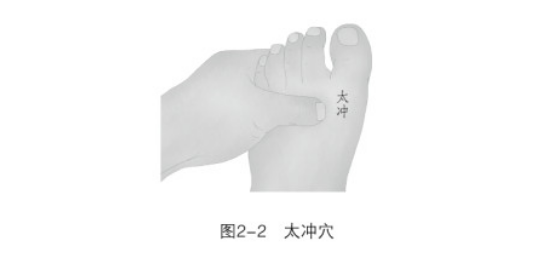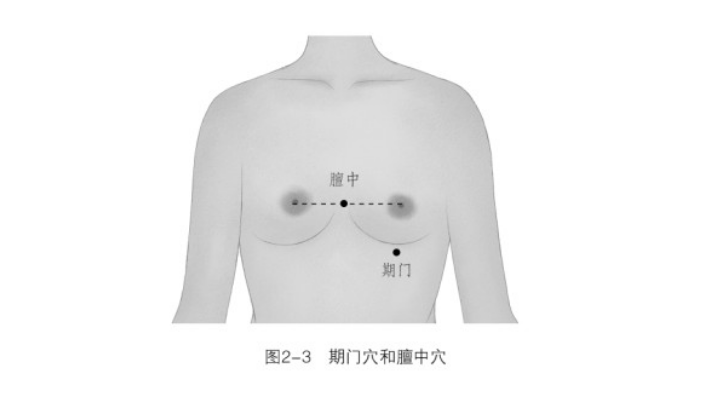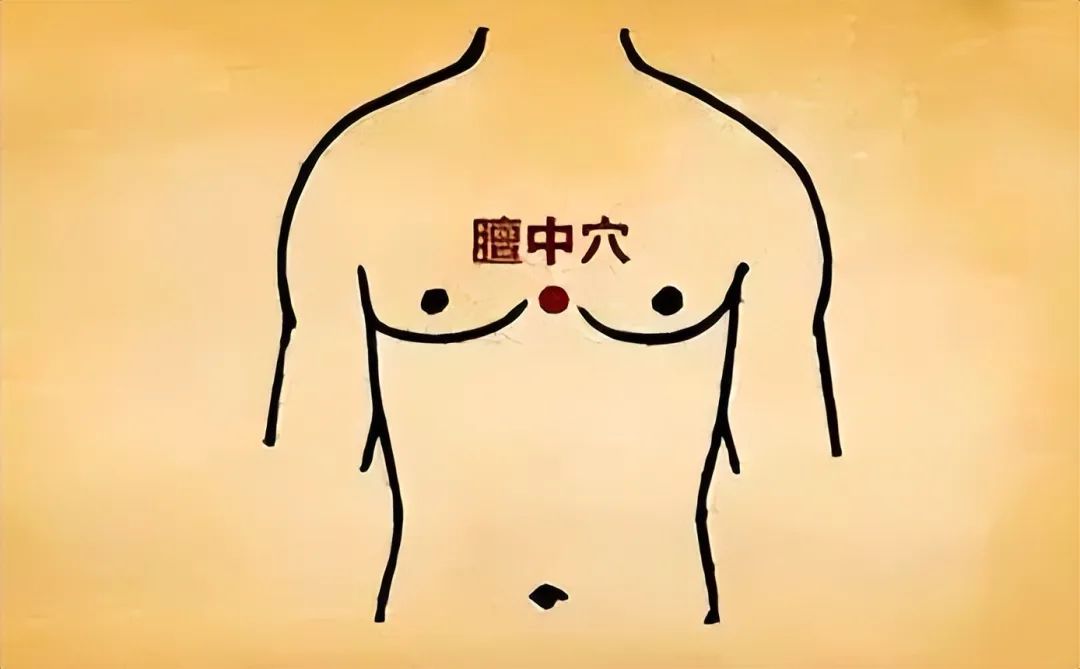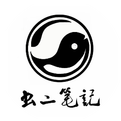—— The following is the main text ——
When I was a child, whenever I made my mother angry, she would put her hands on her hips and point at me, saying, “You make my liver hurt!”After studying Traditional Chinese Medicine (TCM), I realized that this saying is not just casual talk.The liver governs anger; if liver qi is stagnant and there is excess heat in the liver, it can indeed cause discomfort.To treat liver qi stagnation, cupping can also be effective.The specific acupuncture points for cupping are as follows:Taichong (Liver 3)Taichong (太冲穴) (see Figure 2-2) is an acupuncture point on the foot’s Jueyin Liver Meridian, located on the dorsum of the foot, in the depression just before the junction of the first and second metatarsal bones.Cupping at this point can regulate qi, soothe the liver, invigorate blood circulation, and help smooth the flow of qi and blood. Qimen (Liver 14)Qimen (期门穴) (see Figure 2-3) is the mu point of the Jueyin Liver Meridian, located in the sixth intercostal space, four cun lateral to the anterior midline (directly below the nipple).Cupping at this point can soothe the liver, strengthen the spleen, and regulate qi and invigorate blood circulation.It can also be combined with Ganshu (Bladder 18) and Jueyin (Bladder 20) for cupping, which has the effect of soothing the liver, invigorating blood, and resolving stasis, primarily treating chest and hypochondriac distension and pain.If you regularly place your hands on your hypochondrium and rub it, it can also help soothe the liver and relieve stagnation.
Qimen (Liver 14)Qimen (期门穴) (see Figure 2-3) is the mu point of the Jueyin Liver Meridian, located in the sixth intercostal space, four cun lateral to the anterior midline (directly below the nipple).Cupping at this point can soothe the liver, strengthen the spleen, and regulate qi and invigorate blood circulation.It can also be combined with Ganshu (Bladder 18) and Jueyin (Bladder 20) for cupping, which has the effect of soothing the liver, invigorating blood, and resolving stasis, primarily treating chest and hypochondriac distension and pain.If you regularly place your hands on your hypochondrium and rub it, it can also help soothe the liver and relieve stagnation. Shanzhong (Ren 17)Shanzhong (膻中穴) (see Figure 2-3) is located in the chest, at the level of the fourth intercostal space, on the anterior midline (between the two nipples).Cupping at this point can invigorate blood circulation, open the chest, regulate qi, and relieve cough and asthma.Even massaging this point can have a good effect, alleviating symptoms such as chest tightness, cough, and vomiting.
Shanzhong (Ren 17)Shanzhong (膻中穴) (see Figure 2-3) is located in the chest, at the level of the fourth intercostal space, on the anterior midline (between the two nipples).Cupping at this point can invigorate blood circulation, open the chest, regulate qi, and relieve cough and asthma.Even massaging this point can have a good effect, alleviating symptoms such as chest tightness, cough, and vomiting. When cupping at the above points, if there is no significant discomfort, leave the cups on for 10-15 minutes.Generally, a course of treatment consists of 10 sessions, which can be done long-term.The different colors of the cupping marks reflect each person’s constitution and physical condition:Dark purple marks indicate the presence of blood stasis;Dark red marks indicate heat and more severe pathological changes;Pale and slightly swollen marks with moisture on the inner wall of the cup indicate yang deficiency of the spleen leading to water retention;Marks with clear surface patterns, enlarged pores, and slight itching indicate wind and dampness.During cupping, one may feel local tightness, coolness, or swelling; if there is no significant discomfort, the cupping marks will naturally fade in 3 to 5 days without special treatment.A Chinese patent medicine that soothes the liver, strengthens the spleen, and clears liver fire,is recommended for all those who are troubled.Do you often get angry, feel overwhelmed, have dry eyes, increased bloodshot eyes, and sweat easily?Sometimes you may also feel a dry and painful throat, and your face may appear red; these symptoms indicate liver qi stagnation, spleen deficiency, and liver fire.With the current high-pressure lifestyle, some people often stay up late and overeat, which can easily lead to liver qi stagnation and spleen and stomach weakness.Some may also exhibit signs of excess heat; some choose to use Xiao Yao Wan (Free and Easy Wanderer Pill) to soothe the liver and relieve stagnation, but the effect may not be very good.Today, I recommend Jiawei Xiaoyao Wan (Modified Free and Easy Wanderer Pill), which is based on Xiao Yao Wan but adds two herbs that clear damp-heat, namely, Mudanpi (Moutan Root) and Zhizi (Gardenia Fruit).Thus, it is also called Jiawei Xiaoyao Wan or Dan Zhi Xiaoyao Wan, which can soothe the liver and relieve stagnation while also clearing liver fire.When liver qi flows smoothly, the mood will naturally be pleasant.In addition to Mudanpi (Moutan Root) and Zhizi (Gardenia Fruit), the other ingredients of Jiawei Xiaoyao Wan include Fuling (Poria), Baizhu (Atractylodes), Danggui (Angelica Sinensis), Baishao (White Peony), Chaihu (Bupleurum), Gancao (Licorice), Shengjiang (Fresh Ginger), and Bohe (Peppermint).Fuling and Baizhu can strengthen the spleen and transform dampness; if the spleen is not functioning well, it can produce dampness and affect digestive function, leading to symptoms such as loss of appetite, abdominal distension, and loose stools.Chaihu and Bohe can both soothe the liver and relieve stagnation; almost all formulas for soothing the liver and relieving stagnation include Chaihu.Bohe has a pungent and cool nature, which is good for the head, so it can also clear the head for headaches and dry mouth caused by excess liver fire.Next, Danggui and Baishao can nourish and regulate blood, and Baishao also has the effect of softening the liver and relieving pain, which is beneficial for pain in the hypochondrium and headaches caused by liver qi stagnation.Gancao can harmonize the spleen and stomach, while Shengjiang’s dispersing nature can enhance the liver-soothing effects of Chaihu and Bohe.Mudanpi clears heat and cools the blood, entering the liver channel, and is effective for clearing liver fire caused by stagnant liver qi.Zhizi clears heat, drains dampness, and alleviates irritability; it belongs to the Sanjiao channel and effectively clears heat from the upper, middle, and lower jiao.When liver qi is stagnant, the flow of qi and blood is obstructed, leading to heat generation.Moreover, liver qi stagnation also affects the liver’s ability to store blood, resulting in blood deficiency, which can also easily generate heat. This is what TCM often refers to as “liver qi transforming into fire.”What we commonly refer to as “excess liver fire” is all due to the heat in the qi and blood causing disturbances.Zhizi and Mudanpi both have heat-clearing properties; Zhizi clears heat from the qi, while Mudanpi clears heat from the blood. When these two herbs are used together, the heat generated in the qi and blood due to liver stagnation will be cleared.Clinically, it has been observed that there are many patients with liver qi stagnation today, and it can quickly develop into the stage of “liver qi transforming into fire,” presenting symptoms of heat in the qi and blood.For example, irritability, insomnia, bitter taste in the mouth, yellow greasy tongue coating, and yellowing or increased bloodshot eyes.At this time, if one only uses Xiao Yao Wan to soothe the liver, it will have some effect, but it will be relatively slow.If liver soothing is combined with heat clearing, the effect will be much faster.Therefore, adding Mudanpi and Zhizi to the formula of Xiao Yao Wan can both soothe the liver and clear fire, enhancing the formula’s ability to clear liver fire.For those living under the pressures and troubles of modern society, Jiawei Xiaoyao Wan is more suitable than Xiao Yao Wan.Additionally, Jiawei Xiaoyao Wan has another wonderful use, which is to detoxify alcohol.Alcohol is a damp-heat substance; after drinking, it needs to be processed by the liver, which brings damp-heat into the liver.The liver is particularly sensitive to damp-heat; when it encounters damp-heat, it is prone to stagnation.Thus, drinking alcohol harms the liver and can easily lead to excess liver fire. Jiawei Xiaoyao Wan can both soothe the liver and clear heat, and the Baizhu and Fuling in it also have the effect of strengthening the spleen, which can transform dampness.For those who frequently drink, especially during social gatherings, Jiawei Xiaoyao Wan is an essential remedy.However, everyone needs to use it based on syndrome differentiation; if you are unsure, do not use it casually.Excerpted from “Three Steps to Women’s Health” by Luo Dalun.
When cupping at the above points, if there is no significant discomfort, leave the cups on for 10-15 minutes.Generally, a course of treatment consists of 10 sessions, which can be done long-term.The different colors of the cupping marks reflect each person’s constitution and physical condition:Dark purple marks indicate the presence of blood stasis;Dark red marks indicate heat and more severe pathological changes;Pale and slightly swollen marks with moisture on the inner wall of the cup indicate yang deficiency of the spleen leading to water retention;Marks with clear surface patterns, enlarged pores, and slight itching indicate wind and dampness.During cupping, one may feel local tightness, coolness, or swelling; if there is no significant discomfort, the cupping marks will naturally fade in 3 to 5 days without special treatment.A Chinese patent medicine that soothes the liver, strengthens the spleen, and clears liver fire,is recommended for all those who are troubled.Do you often get angry, feel overwhelmed, have dry eyes, increased bloodshot eyes, and sweat easily?Sometimes you may also feel a dry and painful throat, and your face may appear red; these symptoms indicate liver qi stagnation, spleen deficiency, and liver fire.With the current high-pressure lifestyle, some people often stay up late and overeat, which can easily lead to liver qi stagnation and spleen and stomach weakness.Some may also exhibit signs of excess heat; some choose to use Xiao Yao Wan (Free and Easy Wanderer Pill) to soothe the liver and relieve stagnation, but the effect may not be very good.Today, I recommend Jiawei Xiaoyao Wan (Modified Free and Easy Wanderer Pill), which is based on Xiao Yao Wan but adds two herbs that clear damp-heat, namely, Mudanpi (Moutan Root) and Zhizi (Gardenia Fruit).Thus, it is also called Jiawei Xiaoyao Wan or Dan Zhi Xiaoyao Wan, which can soothe the liver and relieve stagnation while also clearing liver fire.When liver qi flows smoothly, the mood will naturally be pleasant.In addition to Mudanpi (Moutan Root) and Zhizi (Gardenia Fruit), the other ingredients of Jiawei Xiaoyao Wan include Fuling (Poria), Baizhu (Atractylodes), Danggui (Angelica Sinensis), Baishao (White Peony), Chaihu (Bupleurum), Gancao (Licorice), Shengjiang (Fresh Ginger), and Bohe (Peppermint).Fuling and Baizhu can strengthen the spleen and transform dampness; if the spleen is not functioning well, it can produce dampness and affect digestive function, leading to symptoms such as loss of appetite, abdominal distension, and loose stools.Chaihu and Bohe can both soothe the liver and relieve stagnation; almost all formulas for soothing the liver and relieving stagnation include Chaihu.Bohe has a pungent and cool nature, which is good for the head, so it can also clear the head for headaches and dry mouth caused by excess liver fire.Next, Danggui and Baishao can nourish and regulate blood, and Baishao also has the effect of softening the liver and relieving pain, which is beneficial for pain in the hypochondrium and headaches caused by liver qi stagnation.Gancao can harmonize the spleen and stomach, while Shengjiang’s dispersing nature can enhance the liver-soothing effects of Chaihu and Bohe.Mudanpi clears heat and cools the blood, entering the liver channel, and is effective for clearing liver fire caused by stagnant liver qi.Zhizi clears heat, drains dampness, and alleviates irritability; it belongs to the Sanjiao channel and effectively clears heat from the upper, middle, and lower jiao.When liver qi is stagnant, the flow of qi and blood is obstructed, leading to heat generation.Moreover, liver qi stagnation also affects the liver’s ability to store blood, resulting in blood deficiency, which can also easily generate heat. This is what TCM often refers to as “liver qi transforming into fire.”What we commonly refer to as “excess liver fire” is all due to the heat in the qi and blood causing disturbances.Zhizi and Mudanpi both have heat-clearing properties; Zhizi clears heat from the qi, while Mudanpi clears heat from the blood. When these two herbs are used together, the heat generated in the qi and blood due to liver stagnation will be cleared.Clinically, it has been observed that there are many patients with liver qi stagnation today, and it can quickly develop into the stage of “liver qi transforming into fire,” presenting symptoms of heat in the qi and blood.For example, irritability, insomnia, bitter taste in the mouth, yellow greasy tongue coating, and yellowing or increased bloodshot eyes.At this time, if one only uses Xiao Yao Wan to soothe the liver, it will have some effect, but it will be relatively slow.If liver soothing is combined with heat clearing, the effect will be much faster.Therefore, adding Mudanpi and Zhizi to the formula of Xiao Yao Wan can both soothe the liver and clear fire, enhancing the formula’s ability to clear liver fire.For those living under the pressures and troubles of modern society, Jiawei Xiaoyao Wan is more suitable than Xiao Yao Wan.Additionally, Jiawei Xiaoyao Wan has another wonderful use, which is to detoxify alcohol.Alcohol is a damp-heat substance; after drinking, it needs to be processed by the liver, which brings damp-heat into the liver.The liver is particularly sensitive to damp-heat; when it encounters damp-heat, it is prone to stagnation.Thus, drinking alcohol harms the liver and can easily lead to excess liver fire. Jiawei Xiaoyao Wan can both soothe the liver and clear heat, and the Baizhu and Fuling in it also have the effect of strengthening the spleen, which can transform dampness.For those who frequently drink, especially during social gatherings, Jiawei Xiaoyao Wan is an essential remedy.However, everyone needs to use it based on syndrome differentiation; if you are unsure, do not use it casually.Excerpted from “Three Steps to Women’s Health” by Luo Dalun.
Further Reading:
-
The Wonderful Use of Maxing Shigan Decoction Combined with Xiao Chaihu Decoction — Influenza Fever
-
Excessive Sweating for Nearly a Year, Turns Out to Be Just Qi Deficiency Sweating!
-
Thick Magnolia Ginger Pinellia Licorice Ginseng Decoction — Recurrent Abdominal Distension
-
Throat Pain and Fever Case
-
The Wonderful Use of Xiao Chaihu Decoction — Thyroid Swelling and Pain
⊙ Note:All formulas and treatments mentioned in this article are for educational reference only. Non-professionals should not attempt to self-medicate; please consult a physician for guidance. This platform does not bear any responsibility for any consequences arising from this. This article is sourced from the internet; if there is any infringement, please contact for removal.
Finally, I would like to introduce my other public account, which has been opened, dedicated to recording classic TCM cases focused on cold damage and warm disease formulas, to prevent loss of contact. So, for those who are interested, please click the link below to follow. Thank you, everyone!

